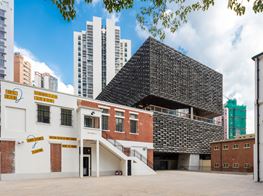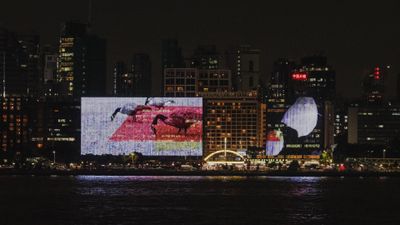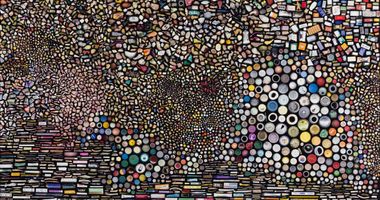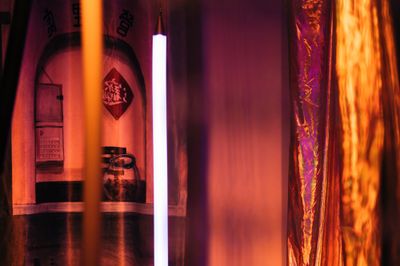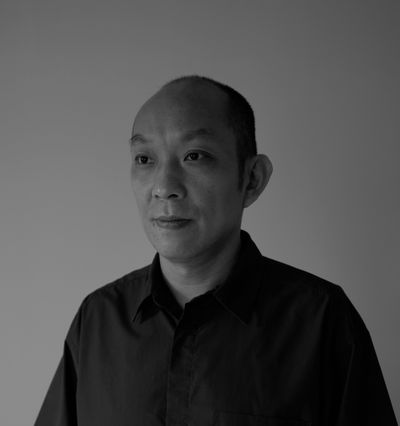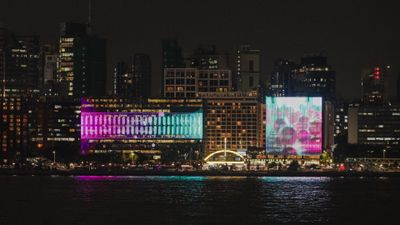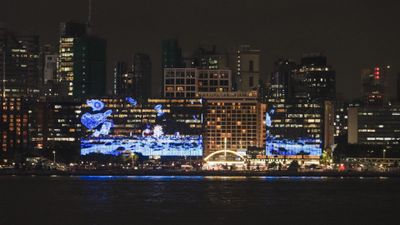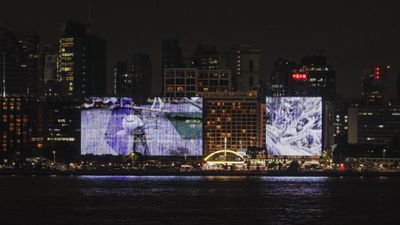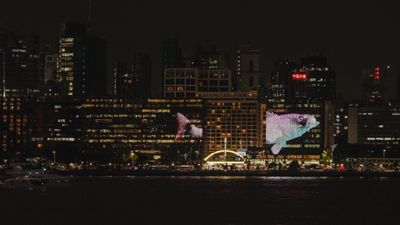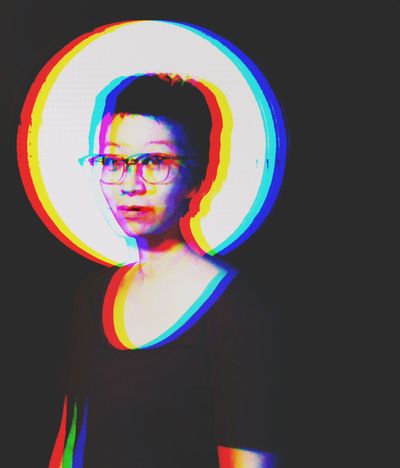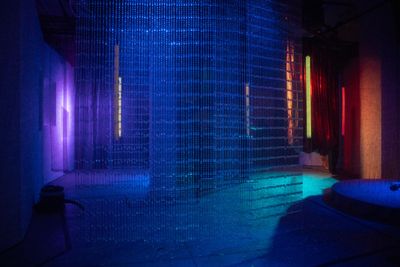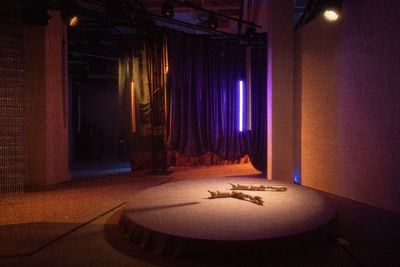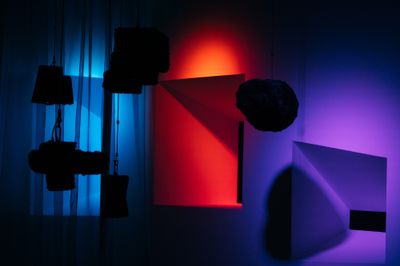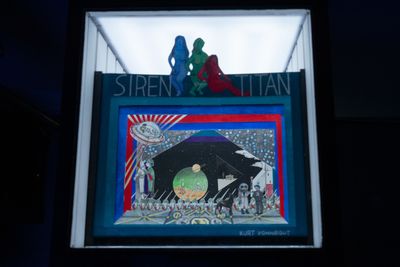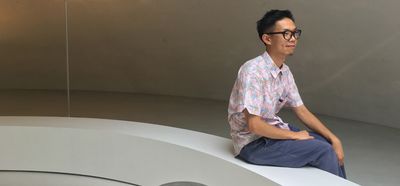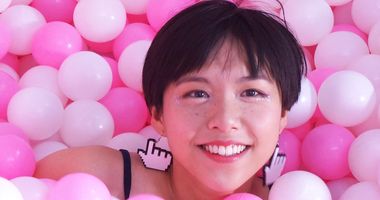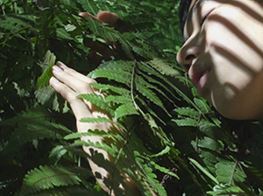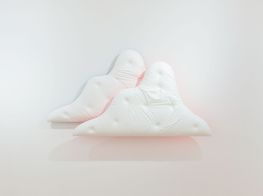ARTS • TECH Exhibition 2.0: Living with Art and Technology
SPONSORED CONTENT | Hong Kong Arts Development Council
Zheng Bo, Bloom by the Sea (2023). Exhibition view: Fill in the Blanks, Sino LuminArt Façade, Tsim Sha Tsui East, Hong Kong (21 October–12 November 2023). Courtesy Hong Kong Arts Development Council.
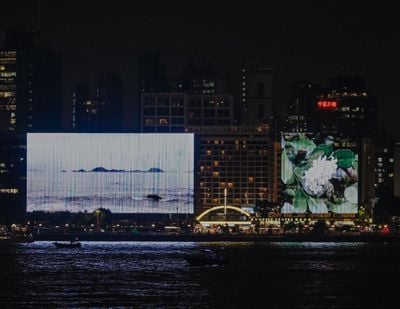
Zheng Bo, Bloom by the Sea (2023). Exhibition view: Fill in the Blanks, Sino LuminArt Façade, Tsim Sha Tsui East, Hong Kong (21 October–12 November 2023). Courtesy Hong Kong Arts Development Council.
In July last year, the Hong Kong Arts Development Council (HKADC) launched 'ARTS•TECH Exhibition', a programme of exhibitions designed to introduce novel, interactive arts experiences to the public by connecting arts, technology, and community. Hong Kong artists Keith Lam, GayBird, and Vvzela Kook were invited to each curate an exhibition that variously explored the relationships between new media, technology, memory construction, and daily life in Hong Kong, resulting in three consecutive shows over three months.
For its second iteration, ARTS•TECH Exhibition 2.0 (21 October 2023–7 April 2024), HKADC has commissioned three Hong Kong-based artists and curators to each present a group exhibition relating to the intersections of art, technology, and community.
The first in this series is Fill in the Blanks (21 October–12 November 2023), curated by artist-curator Ng Tsz-kwan, taking place near the harbourfront at Tsim Sha Tsui Centre and Empire Centre on the Sino LuminArt Façade. Comprising two enormous LED screens, the façade is known for its dazzling displays and earlier this year featured digital works by Spanish artist J. Demsky during the street art festival HKWALLS.
Fill in the Blanks introduces images of nature to the metropolitan horizon through the works of Tap Chan, Ivy Ma, Zheng Bo, and Ng, which share a focus on human interaction with nature. Chan's Lost in Pearls (2023) revolves around Hong Kong's pearling industry, a 1000-year-old industry that collapsed within decades when the city underwent modernisation from the 1950s, while Zheng Bo, who once described their dispersive ecological practice as 'weed-like', turns their lens to flowers that are often overlooked in Hong Kong in Bloom by the Sea (2023). Contrastingly, Ivy Ma brings to Victoria Harbour the various flora and fauna encountered during her travels in the multi-channel video, The Speech of Animals and Plants (2023).
Ng's Lost and Found (2023) follows up on the decluttering craze of the early 2010s, tracking the lives of objects that were decommissioned in favour of clean, minimalist interiors. Populating the façade with images of neglected histories, organisms, and objects, Ng proposes for viewers to reflect on what they might have forgotten and project these memories onto the blank space between the LED screens.
In the new year, curator and creative producer Orlean Lai will follow with Make & Believe at Tai Kwun Contemporary (13–28 January 2024). Described by Lai as a 'performative exhibition', the show examines notions of illusion and reality through theatrical performance with a spectrum of sounds, performances, and scenography.
As with many of Lai's projects, collaboration is key to Make & Believe, involving artists Ng Tsz-kwan, Ho Sin-tung, Tung Wing-hong, Human Wu, and Lam Lai, as well as performers KT Yau Ka-hei, Anson Chan, Pearlmi Tam, and Tung Chung-can, among others. The final piece of the puzzle, of course, will be the viewers, alert to their surroundings as they navigate the gallery's F Hall.
The final stage of ARTS•TECH's second edition is the exhibition Beyond the Singularity at the Showcase in Wong Chuk Hang (16 March–7 April 2024), a study of new ways for integrating AI technology into art and exhibition-making. Curator Isaac Leung, whose research interests encompass video and new media technologies, has devised a programme to familiarise 12 artists with AI technology through workshops and consultations, the product of which will be presented in March.
Participants include artists Stephen Wong Chun-hei and Mak Ying Tung 2 (MAK2), calligrapher Chui Pui-chee, and researcher and critic Phoebe Wong, who were asked to join in part for their diverse artistic backgrounds. This invitation reflects Leung's belief that 'media art isn't solely the domain of tech-savvy younger generations', in a call for new adventures that surely extends beyond the art world.
In the following conversation, curators Ng Tsz-kwan, Orlean Lai, and Isaac Leung independently discuss their upcoming programmes for ARTS•TECH Exhibition 2.0, their approaches to exhibition-making, and the potentials for collaboration and experimentation.
Ng Tsz-Kwan, Curator of Fill in the Blanks (21 October–12 November 2023)
SPHuman interaction with nature, or the exploitation of nature, is a recurring theme in the exhibition. How did the ideas for Fill in the Blanks develop?
NTKWhen conceiving the conceptual framework for this exhibition, I began by considering the physical properties and context of the display medium that would host these works. As Fill in the Blanks would be presented on Sino LuminArt Façade, an immense outdoor LED structure, I reflected on how this unique format and scale might intersect with and catalyse the various artistic practices involved.
Rather than pursue a formalist curation focused solely on the technical attributes of the medium, I was drawn to envision how the facade's location, visibility, and towering proportions could meaningfully inform each artist's exploration of themes important to our social moment. As a massive digital canvas embedded within the urban fabric, it posed both opportunities and responsibilities that demanded consideration beyond aesthetics.
From there, ongoing discussions with Tap, Ivy, and Bo allowed their individual interests, crystallising at the intersection of context and medium, to organically emerge. Each contributor engaged the massive interactive structure and transient viewership it facilitated in critically conscious yet imaginative ways. This aligned our exhibition conceptually between site, practice, and subject matter, cultivating a holism transcending any single approach.
A common characteristic that unites our individual practices is a commitment to sustained, investigative explorations that privilege intimate observation over superficial spectacle. It's a commitment to looking closely at the mundane and overlooked, seeking not to reveal what is spectacular, but to illuminate the extraordinary hidden in plain sight.
In my work Lost and Found, I sought to explore the permeable boundaries between self and other that we often take for granted. Both physically and mentally, we leave parts of ourselves in the places and things we encounter even as outside influences shape us in turn. With the discarded objects, it was not sensationalism that compelled them, but prolonged reflection on the invisible ties binding an item to the user. Through these unconscious yet impactful interactions, definitions of 'self' become fluid. There is resonance with ancient Chinese ideas of 'forgetting the object through appreciating nature'—by immersing ourselves in our surroundings, we expand beyond superficial designations.
As invisible imprints linger in the places we traverse materially and psychically, subtle but profound relationships transpire, binding one another in symbiosis across scales. Through Lost and Found, I hope to trigger stillness amid this flow, inviting contemplation of our merged presence within holistic networks too easily considered 'other'. The installation brings together disparate pieces, like the way phantom limb sensations persist where parts once were, calling to mind invisible yet perpetual bonds woven across lives and landscapes.
If viewers felt whispers of those imperceptible, omnipresent affiliations, my aim was realised in nurturing care for the reverberating totality of our shared past, present, and future habitat. Ultimately, I sought to represent through the arrangement of anonymous castoffs how intersectional, and interdependent our existences are within greater systems—physical, mental, and communal alike. It was my aspiration that glimpsing these interconnections might inspire compassion and reconsideration of relationships that are too often taken to be simple or separate.
Similar excavations of complexity underpin works by Ivy, Bo and Tap in Fill in the Blanks, each illuminating multifaceted implications through individualistic and complementary creative languages.
Ivy's multi-channel video The Speech of Animals and Plants particularly resonates, given her experiences as a world traveller. Having adopted a nomadic lifestyle sojourning between global cities in recent years, Ivy has cultivated intimate insights into varied lifeforms through daily routines that include exploration and observation. Taking inspiration from the simple but hypnotic mechanics of the Marble Run toys, Tap's Lost in Pearls evokes a sense of dreamlike wonder and satisfaction, drawing viewers into a state of immersion as they witness pearls embark on their journey across imaginative landscapes.
Meanwhile, Bo's installation Bloom by the Sea pays homage to the often-overlooked coastal flora through serene presentations, echoing the exhibition's aim to cultivate an appreciation for lifeforms that are perceived as inconsequential. Each work approaches these themes through distinct yet complementary lenses, united in their careful observation and recontextualisation of nature's wonders.
When discussing works-in-progress with each artist, I gained an understanding of our shared investments that were emerging independently, emphasising intimate, empathetic, and complex perspectives on humanity's embeddedness within multivariate systems. Where exploitation has become automatic, we hope that viewers find the opportunity to reconsider connections that have been taken for granted or written off for too long. Through imagination and empathy, our exhibition endeavours to shed new light on the living totalities comprising community, opening reflective spaces where relationships may be redefined and responsibilities reconsidered.
I find the concept of weaving artworks into the rotation of commercial videos playing on the LED facade to be a fascinating curatorial approach. Beyond the opening programme, where all four works will be presented together, spacing out the contributions throughout the exhibition period will allow for rich intermingling and serendipitous encounters for viewers navigating the busy thoroughfare.
SPARTS • TECH Exhibition 2.0 connects arts and technology to present novel, interactive public arts experiences. Technology has not always been deployed to better the environment. What would you say is the role of new media art and technology with regards to environmental concerns of the present day?
NTKProgrammes like ARTS • TECH Exhibition 2.0 demonstrate how interactive experiences grounded in play, delight, and open-ended dialogue have capacity to bring faraway threats into intimate focus, sensitising participants across all walks of life. Instead of heavy-handed sermonising, which tends to breed defensiveness, these works activate curiosity and care through discovery. They invite rethinking human and more-than-human relationships not through accusation, but through aesthetics of encounter, surprise, and shared habitats. With proper guidance preventing objectification, new platforms can present opportunities to rekindle personhood that has been obscured far too long or omitted from popular discourse.
These potential platforms depend upon constant vigilance against harm and development grounded in community input. Resources must be conserved, participatory access ensured, and experiences carefully structured to reinforce rather than distract from real-world responsibilities. Locally meaningful implications deserve priority over superficial entertainment that leaves little room for change. But with nuance, emerging fields promise to enrich learning for all ages, expand civic participation in sustainability efforts, and reinvigorate a politics of hope through recreation and social ties as meaningful as direct activism alone.
Ultimately, creative works that leverage new techniques possess the power to reopen imaginations tightly held by prevailing consumer paradigms, reformulating prevailing human-nature relationships and prompting a revaluation of worth that is more-than-capital. This potential warrants support and gives new media art a distinct, necessary role at this critical intersection. Progress requires both vision and vigilance—qualities I believe can guide innovation responsibly when wedded to intent, accountability, and care for life that sustains us.
SPThe LED facade and water tour recall your work Solitude (2018–ongoing), in which automated chairs take the viewer on a journey through the exhibition space. How is your own practice incorporated into your curatorial approach? What kind of relationship are you hoping for the viewer to develop with the works, in the facade and the cruise tours?
NTKHaving explored spatial and perceptual relationships between the audience and environment through works like Solitude, which employ configurative systems that are both active and receptive, it was natural for my curatorial interests in Fill in the Blanks to manifest through a holistic blending of exhibition components. Just as those interactive pieces aimed not to prescribe movement but to cultivate new procedural perspectives, the choreography of works here gently guides discovery through multi-layered sequences and unscripted happenstance. This curatorial posture continues my investigation into how artistic frameworks condition the audience while enabling interpretive autonomy.
Far from imposition, the intent guiding the integrated performative works on the LED facade and water tour is to develop a resonance through line cultivating experiences that are best understood as a dialogue between the participant and their place. By allowing migration between discrete works through immersive and emotive flows, it is hoped something like kinship or care for these artworks and their subjects emerge without coercion. Spatial sequencing of the videos aims to blur boundaries as visitors intuitively circulate among meditative works that address connections in the multi-dimensional systems of which we are a part.
Rather than having the viewer arrive with preconceptions and depart with conclusions, my vision is for the exhibition to ultimately remake relationships—between the viewer and their perceptions, between humans and habitats, between the self and other—whether organic or technological in character. If it prompts the reimagining of interfaces as reciprocal and definitions of community as expansive through empathetic meanderings, I will feel that my aims are achieved. By synthesising investigative practices that interrogate the frameworks shaping experience, I hope that Fill in the Blanks can cultivate capacity for reshaping roles and realising interdependence through immersive, reflective wanderings.
Orlean Lai, Curator of Make & Believe (13–28 January 2024)
SPCould you walk through the development of Make & Believe? What inspired the concept and vision behind the exhibition?
OLThe idea originated from contemplating the nature of theatrical performance. When I was planning the theatre performance We Are for Real (2023) I reflected on how theatre provides a space for 'make-believe'. Conventional understanding sees all elements on stage as made up—story and characters are nothing more than a plotted scheme; set and props are to forge a transported locale. What matters most is cultivating an illusory environment for audiences to immerse within.
In this disguised realm, theatre-goers are accustomed to theatrical representations. With dimmed lights, they actively engage in a collective 'suspension of disbelief' to bring the fictional world to life. By inviting visual artists together with a composer and lighting designer, I saw an opportunity to transform the installation-performance format into a performative exhibition.
I further developed this idea of a staged exhibition through a narrative without direct representation. Mechanised objects and scenographic devices will shape an atmospheric, poetic setting for visitors to imaginatively immerse themselves within through a different kind of 'suspension of disbelief'. The experience is simultaneously performative, engaging visitors' active participation in collectively fashioning the narrative with their imagination and association.
SPCould you elaborate on We are for real and what it means to translate the 'installation-performance' into a 'performative exhibition'?
OLMake & Believe continues my curatorial exploration of intermedia collaborations between artists of different media and genres. The goal is to experiment and create hybrid forms.
The term 'hybrid' originates from biotechnology and refers to new plant or animal organisms possessing DNA from multiple species. When such hybrid creatures are born, they become unique in their own right with their blended DNA unable to be isolated or divided.
Artistic creation follows a similar process—when different mediums or elements are integrated to form a holistic art experience, the individual parts can no longer be extracted as independent works. The work must be appreciated as a unified whole.
I'm excited we can develop the initial theatre performance idea into an exhibition. Transitioning from the installation-performance format of We Are for Real to the performative exhibition of Make & Believe, with the different venue and presentation style will influence audience expectations. The theatrical notion of 'make-believe' may not apply to exhibition visitors. Therefore, we will take a distinctive approach to crafting the exhibition experience while maintaining an emphasis on the performative within a time-based setting.
A key difference is that exhibition visitors at Tai Kwun can freely explore the space within a timeframe, whereas in the theatre performance, the audience remains seated for the duration with a single perspective. In the exhibition, live performances by performers and musicians will only occur periodically, allowing the objects, scenography, lighting, and soundscapes to lead visitors' journeys during opening hours.
SPThe exhibition will be a Gesamtkunstwerk [total work of art], a multi-sensorial experience that combines sights and scenography. What are some of the questions and impressions you'd like for the viewer to return home with?
OLAlthough trained in visual art, I have primarily worked in theatre over the past few years. However, the productions I have curated and produced have not been conventional 'dramatic' theatre. They cannot be defined solely as 'music', though many incorporate music, soundscapes and sometimes operatic elements, or dance, though physical movement may be involved. Some incorporate cinematic or new media creations as well.
The works have always been visual and concept-driven, rather than script-based. It is difficult to categorise them within a single artistic genre as they are intentionally hybrid through an intermedia collaborative approach. The goal is to craft a Gesamtkunstwerk experience—a total work of art/theatre —for audiences.
I hope viewers can fully engage their senses beyond just sight: to listen, feel, imagine, and freely associate meanings while seated or moving freely through the space. The aim is for them to perceive the entirety of the experience as a holistic, integrated whole.
Isaac Leung, Curator of Beyond the Singularity (16 March–7 April 2024)
SPWhat has the process been like? Considering that not all artists in the exhibition are familiar with technology or AI tools, was there any scepticism around the AI workshops?
ILCurrent confirmed artists include Chan Yuk-keung Kurt, Kwok Mang-ho (Frog King), Mak Ying Tung 2, So Hing-keung, Chow Yiu-fai, Joseph Chen, and Castiel Wong (Virtue Village); Wong Chun-hei Stephen, Chui Pui-chee, Phoebe Wong, and a theatre duo – Kingston Lo and David Chan.
In the coming months these artists will participate in workshops focused on AI tools, followed by private tutorials by two AI experts, James Kong and Chan Ka-ming. I'm excited to see these artists acquire new skills in AI technology and employ strategies to create artworks using these tools.
Many of us—including the exhibition designers and several artists—will embrace the process and experimentation as first-time learners of AI tools. I've encountered artists who are sceptical about AI, fearing it may overshadow human creativity. However, our artists lean towards a more open-minded approach, treating this as a collective experiment where we're not anchored to fixed outcomes, but journeying towards an artistic reflection on technology. Many artists were super excited to learn about AI tools; they immediately said yes to my invitation and told me that they have long been thinking about learning AI tools already. To me this indicates that many artists are curious about the potentials brought about by technology.
SPThe artists in this show come not only from the visual arts, but also fields like art criticism or music. Why was it important for you to consider diverse backgrounds such as these?
ILThese artists come from diverse disciplines such as ink art, conceptual art, performance, lyric writing, art criticism, and painting. My vision for this eclectic mix is grounded in the belief that media art isn't solely the domain of tech-savvy younger generations. Technology surpasses mere technical skills: it's ubiquitous and its essence should be captured by artists from all eras and mediums, in particular addressing the potential impact of AI technology.
I think this selection of artists challenges conventional approaches to exhibition-making. We see media art exhibitions that are confined to a handful of artists who use interactive media, painting exhibitions restricted to artists who only use painting as a medium, and so on. I am attempting to see what emerges when artists who use 'older mediums' experiment with the latest technologies. In fact, AI's potential influence spans the entire ecology of art, including art creation, curation, exhibition design, marketing, and criticism. This exhibition is indeed a small ecology of art that reflects on how AI can permeate the broad landscape of artistic production.
SPThe exhibition will consist of works that artists produce with the aid of AI tools. With widespread concern over AI-induced job displacement, what would you suggest is our ideal relationship with AI technology? What would it look like if we began accepting it as 'an unconventional collaborator', as you suggest?
ILThe role that AI might play in the art world, whether as a replacement or collaborator, remains a hotly debated topic. Historically, every technological advancement, like the Industrial Revolution, has both shaped and disrupted society. I believe that AI technology will do the same. Humans have always taken time to adjust, refine, and negotiate new technologies, and this project is a vivid example of how humans are capable of interacting with new tools.
While AI excels at repetitive, predictable tasks, it's less adept in realms requiring creativity and unpredictable input, like art. Connecting inventive artists to AI tools is super intriguing to me. It lets us witness AI's capabilities when confronted with individuals who are at the forefront of creativity. I believe the inherent unpredictability of this project distinguishes it from other exhibitions. Who knows what the result will be? I believe the process of this project is what makes this exhibition interesting. In addition to the artworks, the exhibition will feature information about the potential impact of AI technologies. The design of the exhibition is done by Cheng Chi Lai Howard, who will turn Showcase into a labyrinth that allows audiences to navigate a journey that reflects on technology. The exhibition is a mix of educational and experimental artistic outcomes of the process. I'm excited to see how the exhibition space will be turned into a multi-purpose platform that is different from conventional white-cube presentations. —[O]

